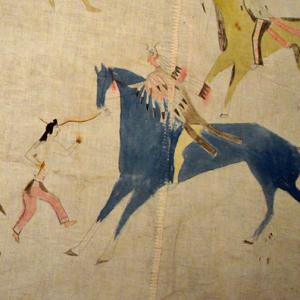Lakota people
Indigenous people of the Great Plains
The Lakota people (also known as the Teton Sioux) are a Native American tribe and one of the three subcultures of the Sioux people. They are indigenous to the Great Plains region of the United States, primarily inhabiting areas in South Dakota, North Dakota, Nebraska, and Minnesota.
Etymology[edit | edit source]
The name "Lakota" is derived from the Lakota autonym, meaning "allies" or "friends." The term "Sioux" is an exonym derived from a French transcription of an Ojibwe term.
History[edit | edit source]
The Lakota people have a rich history that dates back centuries. They were originally part of the Woodland culture of the Great Lakes region but migrated westward to the Great Plains in the 17th and 18th centuries. This migration was driven by a combination of factors, including pressure from other tribes and the search for new hunting grounds.
19th Century Conflicts[edit | edit source]
The 19th century was a tumultuous period for the Lakota, marked by numerous conflicts with the United States government. Notable events include the Battle of the Little Bighorn in 1876, where Lakota warriors, along with their allies, defeated the 7th Cavalry Regiment of the United States Army. Another significant event was the Wounded Knee Massacre in 1890, which resulted in the deaths of hundreds of Lakota men, women, and children.
Culture[edit | edit source]
The Lakota culture is rich in traditions, spirituality, and social structure. They are known for their elaborate ceremonies, such as the Sun Dance, and their deep connection to the natural world.
Language[edit | edit source]
The Lakota language is a member of the Siouan language family. Efforts are ongoing to preserve and revitalize the language, which is considered endangered.
Social Structure[edit | edit source]
The Lakota social structure is organized into bands, each led by a chief. The bands are further divided into extended families. Decision-making is often communal, with a strong emphasis on consensus.
Modern Day[edit | edit source]
Today, the Lakota people continue to live in their traditional territories, primarily on reservations in South Dakota and North Dakota. They face numerous challenges, including economic hardship and health disparities, but continue to work towards cultural preservation and self-determination.
Notable Lakota[edit | edit source]
- Sitting Bull - A renowned Lakota leader and warrior.
- Crazy Horse - A prominent war leader known for his role in the Battle of the Little Bighorn.
- Black Elk - A famous Lakota medicine man and holy man.
Related Pages[edit | edit source]
- Sioux
- Dakota people
- Nakota people
- Great Plains
- Battle of the Little Bighorn
- Wounded Knee Massacre
- Sun Dance
- Sitting Bull
- Crazy Horse
- Black Elk
| Indigenous peoples of North America |
|---|
|
This Indigenous peoples of North America related article is a stub.
|
Search WikiMD
Ad.Tired of being Overweight? Try W8MD's physician weight loss program.
Semaglutide (Ozempic / Wegovy and Tirzepatide (Mounjaro / Zepbound) available.
Advertise on WikiMD
|
WikiMD's Wellness Encyclopedia |
| Let Food Be Thy Medicine Medicine Thy Food - Hippocrates |
Translate this page: - East Asian
中文,
日本,
한국어,
South Asian
हिन्दी,
தமிழ்,
తెలుగు,
Urdu,
ಕನ್ನಡ,
Southeast Asian
Indonesian,
Vietnamese,
Thai,
မြန်မာဘာသာ,
বাংলা
European
español,
Deutsch,
français,
Greek,
português do Brasil,
polski,
română,
русский,
Nederlands,
norsk,
svenska,
suomi,
Italian
Middle Eastern & African
عربى,
Turkish,
Persian,
Hebrew,
Afrikaans,
isiZulu,
Kiswahili,
Other
Bulgarian,
Hungarian,
Czech,
Swedish,
മലയാളം,
मराठी,
ਪੰਜਾਬੀ,
ગુજરાતી,
Portuguese,
Ukrainian
Medical Disclaimer: WikiMD is not a substitute for professional medical advice. The information on WikiMD is provided as an information resource only, may be incorrect, outdated or misleading, and is not to be used or relied on for any diagnostic or treatment purposes. Please consult your health care provider before making any healthcare decisions or for guidance about a specific medical condition. WikiMD expressly disclaims responsibility, and shall have no liability, for any damages, loss, injury, or liability whatsoever suffered as a result of your reliance on the information contained in this site. By visiting this site you agree to the foregoing terms and conditions, which may from time to time be changed or supplemented by WikiMD. If you do not agree to the foregoing terms and conditions, you should not enter or use this site. See full disclaimer.
Credits:Most images are courtesy of Wikimedia commons, and templates, categories Wikipedia, licensed under CC BY SA or similar.
Contributors: Prab R. Tumpati, MD







